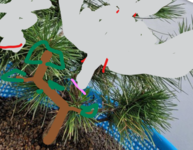Telperion farms developed some amazing stock. The casual observer might think it was simply due to ground growing and the prime location. However a lot of technique and constant attention to the smaller details often goes unnoticed when describing their work.
Telperion adjusted their growing methods with continuous improvement. Make sure you understand what all that process entailed.
If you are focussing on ground growing and/or just the trunk thickness first you will have missed the complexity of the process they developed eventually. Technique and timing was important within their process.
The thicker your trunk, the older the tree, the less likely to obtain back budding on the trunk lower down for additional branching and design improvement. By the time the trunk is 3/4 inch thick wiring has a limited effect with softer gentle curves most likely! Wiring to add more exaggerated movement and turns should be done in the first two to three years of development on the lower section. Generally considered to be the section up to the first primary branch, but not always.
Trunk movement if desired needs to be developed with a combination of methods if it involves taper as well. If one wishes to avoid subtle curves then one must wire with more exaggerated movement initially as well as select carefully the angle of change for the new apical leaders as the trunk is built section by section for taper . Do not wait for wiring until the trunk gets thicker if you want to introduce movement. You can introduce change of direction with pruning but the best result will be a combination of pruning and wiring when changing apical leaders. Unless of course you wish to build with straight sections. Even then professionals often use wire and bracing to develop upright formals with taper. This allows them to keep the new apical leaders straight in line with the lower portion as it develops.
It is important to remember that growth and thickening often softens the appearance of movement, change of direction and taper. hence the importance of developing a more robust version of the desired final appearance.




